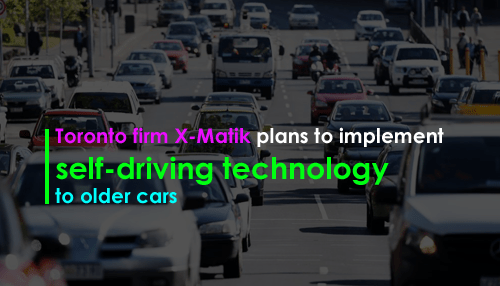Upcoming time is going to draw a virtual line between the car owners, one who desires to purchase the autonomous vehicle and one who plans to purchase manually operating a vehicle, a driverless car. Nima Ashtari desires to empower that second group to welcome the upsides of self-driving automobiles, also. X-Matik Inc., his Toronto-based company, this month is launching a test version of its first commercial product– LaneCruise, an add-on unit that assurances to change in every practical sense any present car into a not entirely autonomous vehicle for under $3,000.
“It’s truly striking when you see folk’s reaction to it,” he says. “It’s ordinarily one of stunningness and amazement that you can fulfill something like this with so negligible consumption and no necessity for another car.”
Ashatri says Lane Cruise is composed of many components, requires about an hour to install all components. The key part is an LCD interface that houses a forward-looking camera, which joins to a car’s back view mirror.
The movements of the vehicle are tracked by the camera and transfer this information into a processing unit underneath the driver’s seat.
Controlling of the air vehicle is done by the actuators, which have been attached to the steering wheel and pedals and enables the driver to cruise hands – and foot-free, like existing frameworks, for example, Tesla’s Autopilot and Nissan’s ProPilot.
LaneCruise is much similar an advanced form of cruise control since it enables a vehicle to keep up a set separation and speed behind another car. The driver, be that as it may, needs to keep focusing out and about.
The system is furthermore able to switch the lanes automatically, Ashtari says, however, the driver needs to start the lane-change indicator, which is a bit of the X-Matik unit, to do in that capacity.
The function won’t be comprised at first in the beta kit, which is being confined to 200 units to buyers in Ontario. The company needs to collect further data from test customers to check whether additional cameras ought to be installed around the vehicle before an organized full launch one year from now.
The test program is blending with X-Matik’s appearance on Dragon’s Den on Nov. 16, in which Ashtari – a past mechanical engineer for Tesla and Honda – made sense of how to secure $350,000 in funding.
The company has also pulled in a further $500,000 in funding from an angel investor, which has empowered it to help staff to 12, from three at the beginning of the year. Ashtari needs to acquire another 10 employees in the next three months.
X-Matik is one of seven entities to get underwriting from the Ontario government to test self-driving cars on the province’s roads. The others are Uber, the University of Waterloo, Erwin Hymer Group, BlackBerry’s QNX, Continental, and Magna. X-Matik says its system has logged 56,000 kilometers since testing began a year prior.
Ashtari has high praise for the government to give smaller companies the opportunity to take an intrigue close-by more prominent contenders. “Ontario saw that our technology was on par with pretty much anything else they’ve seen,” he says. “If solitary tremendous companies are allowed to innovate, then headway will be genuinely direct.”
More noteworthy companies have been less kind. Tesla, particularly, has been denouncing of Comma.ai, a U.S.- based company that is working on similar market autonomy.
“It is to an extraordinary degree outlandish that a singular individual or even a little company that requirements wide planning endorsement capacity will have the ability to convey an independent driving structure that can be sent to age vehicles,” the electric car maker has said. “It may work as a limited demo on a known stretch of road … but then requires enormous resources to debug over millions of miles of widely differing roads.”
Industry experts are wary, calling attention to that X-Matik’s unit does not have a portion of the propelled technologies being incorporated with driverless cars by bigger companies, for example, laser-radar and sonar.
Regardless, they moreover observe that making self-driving technology more sensible, instead of a luxury, will be key to its broad apportionment.
Nigel Wallis, vice-president for an internet of things and industry research at IDC Canada says “You can’t go out and buy a new Tesla if you’re a student,” “Being prepared to democratize self-driving cars has ensured.”
Ashtari yields his company’s system has limitations because of its nonappearance of extra sonar and radar, however, adds that it warns drivers when those parameters reach beyond the predefined limit to manual override. “We’re quite used to hearing that skepticism,” he says.

